Sorted by date Results 1 - 25 of 74

For the special Homecoming edition on Oct. 22, 1951, reporters from the Shelton High School newspaper, "The Saghalie," interviewed several SHS "students of yesteryear." This story is from those interviews. Mrs. Horace Crary (Geneva Sargison) was in the second class to graduate from Shelton High School, in 1911. The 50 high school students occupied the upper floor of the newly built Lincoln School and "were principally interested in education, since activities were few." Team sports offered...

On the occasion of his 80th birthday in April 1938, William "Billy" Sargison was interviewed for a front-page article in the Journal. "Hale, hearty, and active," Bill referred to the diary he had kept for half a century to refresh his memory. Bill was born in LaGrande, Maine, on April 6, 1858. Twenty-six years later, he set out with his friends Frank Hathen and George Weymouth to cross the country in "poky, smoky rattletrap trains" that took a full two weeks to transport them to the West Coast,...
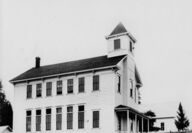
The town of Hoodsport was officially created Aug. 1, 1890, when Vincent and Ida Finch went to Shelton and signed a certificate naming their property Hoodsport and dedicating the streets and alleys to the public forever, except for the right to grant right of way to the railroads. By 1892, the combined population of the Hoodsport and Lake Cushman area was 145. The United States government sent a surveyor to the Cushman District, who changed survey lines from the north and west. The results were...

James Hodkinson was born in Matlock, Derbyshire, England, in 1833. He emigrated to America in 1882 and was one of the earliest settlers in the Satsop Valley. When he became the area's first postmaster, he gave it the name of Matlock, after his hometown. A 1901 supplement to the Mason County Journal included two pages about "the thriving and prosperous town of Matlock, situated about 17 miles from Shelton in the midst of the great timber district." Matlock was 3 miles from the railroad line that...
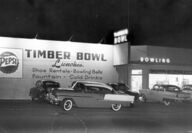
This story is from the July 28, 1955, edition of the Shelton-Mason County Journal. "Shelton wrapped welcoming arms around the community's newest recreation center, the Timber Bowl, last weekend during a three-day grand opening that exceeded the fondest hopes of owner L. L. McInelly and manager Eddie Hurd. Approximately 1,000 bowling strings were rolled between 9 Friday night and closing time Sunday night, when a special introductory offer of one game free for each two bowled terminated....

In October 1870, Eva Kiddell was three months short of being 5 years old, living with her grandmother in Chicago, when her family decided she should be the one to accompany her Aunt Sara Shepherd to the "wilderness of Mason County," where Sara was to become the bride of Captain Ed Miller. The two made the long journey by train to San Francisco, then by boat to Victoria, and on to Hammersley Inlet. In 1950, Eva wrote some of her memories for the Daughters of the Pioneers of Washington (which she...

In about 1905, a school was built in the Pickering area of Mason County. Because there was only one student at the time, the building may have been intended as a temporary structure. In June 1912, a new, more permanent Grant School was built on logged-off land overlooking Pickering Passage. By November 1917, 12 students attended the new school and by 1928, 28 students attended in grades one through eight. According to the Journal, on Nov. 26, 1915, "The greatest social event of the season was...

From the Aug. 10, 1939, Journal "The Phoenix Logging Company, Mason County's second largest logging railroad operation, recently hauled out its last logs and closed its camps for good, having cut during its life of nearly 40 years nearly all of the private timber in the Lake Cushman region (about 1½ billion feet of timber). The Phoenix operation has cut all timber available on lands owned by the company in the foothills west of the canal extending from the bend in the north fork of the...

The following items are from the "Local and Personal" pages from June, July, and August issues of the 1920 Journal. June 11: J. Y. Waldrip recently installed a new milking machine on his dairy farm at the head of Oakland Bay, and it is reported to be a great labor saver in the milking of some 30 cows. The county commissioners have been in session this week disposing of the usual routine business. A franchise for distributing electric current over the roads of Mason County was granted to the Olym...
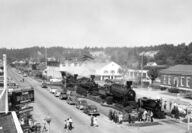
From the Shelton-Mason County Journal, June 6, 1946. "Among the interesting features of the recent Forest Festival was the display of Simpson Company locomotives, from the first and original No. 1, 15 tons, to several of the newer and larger engines weighing up to 110 tons." Engine No. 1, built by H. K. Porter Company, was barged into Shelton in 1885 for what was then known as the Satsop Railroad, later Simpson Logging Co. It was officially named "C. F. White" but became known affectionally as...
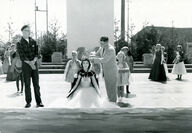
The May 29, 1958, Journal was printed on green paper and featured enthusiastic reports on Forest Festival activities that had taken place the previous weekend. The first story, titled "Forest Festival Draws Huge Crowd from Pacific Northwest," claimed that 25,000 to 40,000 visitors had flocked to Shelton for the festivities. An official traffic count showed more than 55,000 vehicles coming into and leaving Shelton between Friday and Sunday evenings. The Queen's Coronation and Pageant had been...
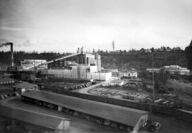
On May 11, 1939, the Journal announced Shelton's annual cleanup effort. "With the city offering its cooperation next week, Shelton's annual Cleanup Week will be from Monday May 15 through Saturday May 20. So, this little logging and rayon center should wake up and find itself all spic and span a week from Sunday morning." City residents were asked to clean up their yards, clear out attics and basements, and scrub up the garage and woodshed. The resulting accumulation of unwanted junk and...
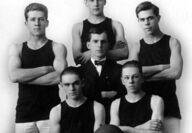
In 1909, H. Enzo Loop, age 28, somewhat reluctantly traveled by steamship from Tacoma to Shelton at the recommendation of his mentor, Mr. Layhue, the deputy state superintendent of schools, to be interviewed for the position of superintendent of Shelton Schools. Loop had a Teacher's Elementary School certificate, after studying for a year at Whatcom Normal School, and had taught for one year at Eastsound School in San Juan County. In the waters near Olympia, Loop transferred to the boat going on...
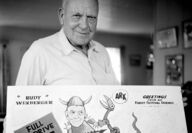
"He could be blustery. He could be rough and tough. He could be nice and kind and gentle. Whatever his moods - and most people judged him by either his faults or virtues - there was only one Rudy Werberger." This was the opening paragraph of a memorial article about Mason County grape grower, wine maker and Forest Festival promoter Rudy Werberger, written by Dave James in 1985. Rudy Werberger was born in Austria in 1881. At the age of 20 he emigrated to Roslyn, Washington, got a job in the...
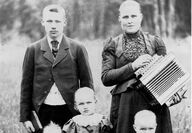
In her book "Long, Long Ago in Skokomish Valley," written in 1965, Emma Richert included a chapter on transportation. In the very early days in Skokomish Valley, transportation consisted of horse-drawn wagons or buggies, or riding horseback. By 1893, bicycles were coming into popular use. In 1897, Barber Wehnes rode her bicycle from Shelton to visit the Will Hunters in the Valley in an hour and a half - a "nice record," according to the Journal. Emma remembered the crookedness, the narrowness an...
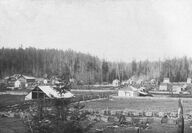
David Shelton and his family took up residence in Sawamish - now Mason - County in 1853. They built their first home at the edge of Big Skookum (Oakland) Bay, approximately where the Shelton Yacht Club is today, and the area became known as Shelton's Point. Most new arrivals were settling at Oakland, approximately halfway between Shelton's Point and what is now Bayshore, which had been officially designated as the county seat; however, a small community began to form at the Point. By 1879,...
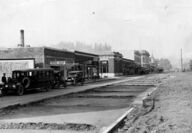
This story is from several editions of the Shelton-Mason County Journal published in 1923. In March 1923, the state of Washington appropriated more than half a million dollars to improve highways within Mason County, making way for the most extensive road operations in the history of the county. The biggest project was in Shelton and included an entirely new route for the Olympic Highway from Mill Creek into downtown. The county had built the existing route - which we now know as Pioneer Way -...
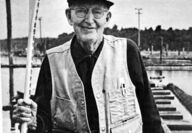
The November-December 1976 issue of the Simpson Magazine included a story titled "Babe Munson: Boom Boss of the Water Loggers." This story is based on information in that story. In 1889, Albert J. Munson and his wife, Esther, moved from Steilacoom to Shelton, where Albert opened a furniture and stationery store and served in several public offices, including deputy sheriff, county clerk, city treasurer, justice of the peace, police judge and postmaster. Albert and Esther's middle son, born in...
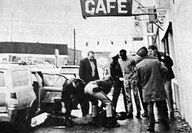
On Feb. 1974, two armed men who had robbed a Kentucky Fried Chicken restaurant in Bremerton were thought to be on their way to Shelton. Their getaway car was stopped in Belfair about 8 p.m., and a young woman, the only occupant, was taken into custody. Twenty-three law officers from the Mason and Kitsap County sheriff departments, the Bremerton Police Department, and two detachments of the Washington State Patrol were involved in searching for the suspects. Roadblocks were set up in the area,...

John Campbell was born in Stirlingshire, Scotland, in 1830. As a young man he was working as a mate on a sailing ship when he met and became engaged to Mary Duncan, an Edinburgh lass living in Australia. In 1859, he arrived in San Francisco and traveled north until he reached the head of Little Skookum Inlet, near Kamilche, where he settled. Mary Duncan arrived in Olympia in 1860, "with trunks of finery," and the two were married May 12. Between 1869 and 1880, John Campbell kept a diary about hi...
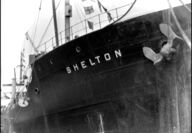
In 1928, the newly organized Tacoma-Oriental Steamship company purchased seven freighters and renamed each of them for a Pacific Northwest town or county. The SS Cuprum was renamed Shelton. The remaining six ships were named after Seattle, Tacoma, Everett, Bellingham, Olympia and Grays Harbor. Mason County Journal Editor Grant Angle wrote: "The budding City of Shelton ought to feel 'all puffed up' over the nice recognition of its present and prospective part in the shipping affairs of Puget...

To commemorate the first anniversary of the Japanese attack on Pearl Harbor, the Shelton Active Club conducted its second citywide scrap metal drive Sunday, Dec. 6. City residents were asked to have their scrap out by 10 a.m. to be picked by Activans driving donated trucks. Stockpiles were established at 7th and Franklin downtown and at the air raid tower on Hillcrest. The first scrap drive, a few weeks earlier, had collected over 30 tons of valuable scrap metal. Also on Dec. 6, a twin engine...
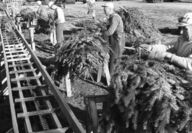
The following story is from the Journal's Mason County Visitor's Guide for 1968. The bright lights on trees from Mason County pop the eyes of boys and girls in 2 million homes every year on Christmas morning. Christmas trees produced here are shipped as far south as Mexico City, east to Kansas and west to the Philippines. California gets 80 percent of the crop. That's why Shelton has earned its unique nickname of "Christmastown U.S.A." This is the place where Santa stops to load his sleigh with...
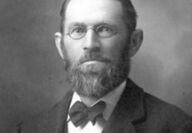
This story comes from the book “Long Long Ago in Skokomish Valley,” by Emma Richert, published in 1965. Some of Emma’s story is based on selections from Myron Eells’ diaries that had recently been published in the Journal. “For many decades the residents of Middle Skokomish have voted in ‘Eells Precinct.’ None of the Eells has lived in the Valley for many years now, but may that name ever be retained in memory and honor of a truly outstanding pioneer family. I am overwhelmed by the impossibi...
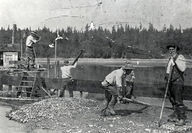
Florence Waldrip was born in November 1893, in her Aunt Mary's house at the head of Oyster Bay. Her father, Joe Waldrip, owned the Olympia Oyster Company in partnership with W. H. Kneeland. In an interview with the Journal in October 1976, Florence recalled her early life at Oyster Bay and New Kamilche. For several years, Joe and his wife, Zora, raised their family on a houseboat in the middle of Oyster Bay. "There were three children and no railing on the porch, so we had to learn to mind our...